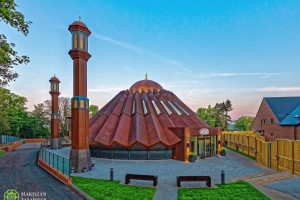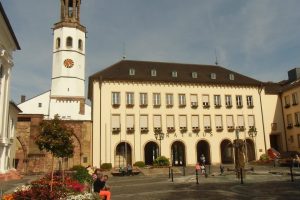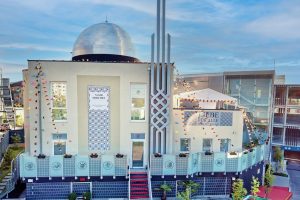
Ansar Bilal Anwar, Germany
‘Let us be courageous and vigilant’ – with these words Chancellor Angela Merkel addressed the members of the Bundestag (German parliament) in her government statement a few days ago, referring to the successes in the fight against the Coronavirus. Thanks to great cohesion and enormous efforts, it has been possible to slow down the spread, she explained in the Bundestag.
This statement was preceded by initial relaxations such as the opening of stores and schools only for examination classes etc. In the course of the second phase of the Coronavirus relaxations, worship services in churches, synagogues and mosques have been permitted again, for the first time since the beginning of May 2020, provided that precautionary measures are taken. Previously, worship services could no longer be held in Germany as of 16 March 2020 due to governmental restrictions to curb the Coronavirus pandemic.
Before these relaxations, there was a long process of coordination between the government and the federal states, the Robert Koch Institute, the churches and religious communities. They had to submit to the Ministry of the Interior ‘comprehensive and feasible concepts for conducting worship services and religious acts in a way that protects against infection’.
The Ahmadiyya Muslim Community in Germany also developed such a concept and sent it to all mosques for implementation. Only after all measures had been ensured was permission granted to reopen mosques and prayer centres.
A mosque is an important place of daily gathering for Muslims, where they meet five times a day to perform their obligatory prayers. Ammar Ahmad, who is also the youth leader of the community Nuur Mosque in Frankfurt, can hardly put his happiness into words. He has been involved in the implementation of the measures on site:

‘The Nuur Mosque is in fact our second home, where we are finally allowed to pray together again, Alhamdulillah! [All praise belongs to Allah]
Under compliance with legal requirements we were able to reopen the mosque on 08 May 2020. One of these regulations is that every praying person has to wear a mouth and nose mask and bring his own prayer mat with him. Before entering the mosque, hands must also be disinfected and the names of the persons must be documented in order to be able to trace back the chains of infection.
With the opening came now also the huge responsibility of the Khuddam-ul-Ahmadiyya [youth organization of the Ahmadiyya Muslim Community] to organize an order service for every single prayer, which ensures the observance of the instructions. Although this is an exhausting task that requires us to be persistent, our Khuddam [youth] are highly motivated to make this effort for the protection of the worshippers.’
One of the purposes of the Islamic prayer in congregation, in which the worshippers stand shoulder to shoulder in rows, is to strengthen the sense of unity. The wisdom of performing obligatory prayers in congregation has been explained by the Promised Messiah (as), the founder of the Ahmadiyya Muslim Community, as follows:
‘Congregational prayer is promised to be more rewarding because it makes for unity. To translate this unity into practice, Islam enjoins with great emphasis that when we line up for prayer, our feet should be in line, the lines should be straight, and all worshippers should stand close to one another with a view to uniting the many into one, so that the light of one should illuminate the others, thus removing the divide which causes egoism and selfishness.
Remember, man is gifted with the power to absorb the light that others radiate. It is for the realization of this unity that we are enjoined to offer daily prayers in the local mosque, the weekly prayers in the central mosque, Eid prayers in the Eidgah, and, once a year, to ensure the congregation of Muslims from all over the world in the House of God— Ka‘bah. The purpose of all these injunctions is none other than forging unity.’
As we know, social distance plays a decisive role in Coronavirus restrictions in order to minimize the risk of infection. The question arises as to what extent this can now be reconciled with the Muslim prayer For guidance and the solution of such and other complex questions, the Ahmadiyya Muslim Community is blessed with the system of the spiritual Caliphate. His Holiness Hadhrat Mirza Masroor Ahmad (aba), Fifth Caliph of the Ahmadiyya Muslim Community, has permitted that in light of the current circumstances, necessary safety distances within a prayer row may be maintained. The distance between two worshippers should be 2 meters each. In addition, one prayer row will be left empty.

This permission is in accordance with the Islamic teaching. In special circumstances of fear, which can be even worse than in a war, the performance of prayer is to be ensured. The Holy Qur’an says about this:
‘If you are in a state of fear, then say your Prayer on foot or riding; but when you are safe, remember Allah as He has taught you that which you did not know.’
The distance regulation during prayer is unusual, but the well-being of worshippers is not to be neglected, as Said Arif, Imam of the Khadija Mosque in Berlin, describes:

‘It was just unusual for everyone to pray at a distance. I returned home right after the prayer without talking to anyone, to set an example for others, so that people would go home to Juma as soon as possible and listen to His Holiness’ Friday sermon on MTA. Nevertheless, people are happy that Juma (the Friday prayer) could be performed again.’
Imtiaz Ahmad Shaheen, Imam of the Nuur Mosque in Frankfurt, describes this unusual situation as follows:
‘It was very unusual to wear a face mask for prayer, to pray with distance to the neighbouring person, not being able to hug the people after the prayer. But my heart was filled with gratitude to Allah that He has given us such a perfect teaching that is suitable for all situations and that we can again perform the Friday prayer in the mosque.’
The distance regulations also have an effect on the number of worshippers allowed in the mosques. If at a Friday prayer in the Khadija mosque in Berlin before these tough times up to 200-250 worshippers would come, now after the regulations the mosque can only accommodate 30-60 worshippers for a prayer. In the worst case, worshippers must be turned away. However, this will hardly ever happen, because at present, due to the safety regulations, people under 15 and above 60 years of age as well as women and children are not allowed to visit the mosques for the time being.
The opening of mosques is limited, because for the time being only the compulsory prayers are allowed. The Sunna (prayers before or after the obligatory prayers according to the practice of the Holy Prophet (sa)), Nafl (optional prayer) or Witr (offered after the Isha prayer) prayers should be performed at home if possible. Also the Tarawih (congregational supererogatory prayer offered after Isha during Ramadan) prayer does not take place in the mosque. Wudhu (ablution) is to be performed at home. Washrooms are not accessible and may only be used in an emergency.
At the moment we are passing through the holy month of Ramadan, when there is usually a great rush in the mosques, as this month stands especially for the acceptance of prayers. How are the Community members coping with this situation? Rastagar Munir, who studies Egyptology and Asian Archaeology in Vienna, had returned to his parents in Frankfurt shortly before the lockdown in Austria. He describes his impressions as follows:
‘At the beginning of May we were able to experience personally that the month of Ramadan brings God’s grace, when our mosques were finally reopened. I remember quite well the discouraged and sad state of mind of everyone when the restrictions were imposed. It was clear to everyone: this is no ordinary time. For eight weeks, we tried to do everything we could to overcome this trial. For eight weeks we abstained from everything that seemed to be self-evident to us so far. It was a very glorious moment when these oases of pure spirituality and bliss were finally filled with life again, because this difficult time taught me that the beauty of the mosque is certainly and only formed by the people who populate it.’
With regards to the restrictions, he says:
‘Even though the situation in the mosques is still strange, as there are still some restrictions, we try not to be scared by it, because this reopening is the first step, and Insha Allah (if Allah wills) will follow all further steps as well, until normality is completely restored. That you have to bring your own prayer mats, for example, I see it with calmness. It reminds me of earlier times, when people brought their own prayer mats to the jalsas (annual meetings) in Islamabad, UK or to the Eid prayer in the sports hall in Frankfurt. I can enjoy these nostalgic memories as long as this continues. After all, one should always make the best out of the situation.’
During the lockdown, prayers in congregation have not been held in the mosques for about eight weeks, where otherwise the call to prayer sounds five times a day. However, the exceptional circumstances did not stop the call to prayer from continuing to be called in the Ahmadiyya mosques nationwide. Imtiaz Ahmad Shaheen elaborates on this aspect and says:
‘I certainly did not want the name of Allah not to be called in the mosque for such a long time, because the proclamation of the unity of God is the purpose of a mosque. So I made sure that five times a day, at all five times of prayer, the Adhan was called. On May 8th the time had finally come. The long-awaited day had come when we could again perform the congregational prayers in the mosque. This was a twofold Eid for us, because it was also a blessed Friday, and the Holy Prophet (peace and blessings of Allah be upon him) has described Friday as an Eid day.’

The mosque is a special place of spirituality, the feeling of which is very tangible. As a result of the lockdown, Muslims were ordered to pray at home. Farhan Manzoor Ahmad, who is studying Islamic theology at the Jamia Ahmadiyya in Riedstadt, is dependent on home-study due to the closure of the institute and conducted the prayers at home. He describes the special value of the mosque after its opening in this way:
‘I am grateful, Alhamdulillah [all praise belongs to Allah] to be able to pray in the mosque again. Even if it was not the normal atmosphere, it was a calming and joyful feeling to pray in the mosque, which you would not experience at home in the same way.’
In Islam one can worship at any place. However, mosques, like other places of worship, are a communal place for people to gather and keep connected. Syed Salman Shah, who is the Imam of an active and tight-knit community in Bremen in northern Germany, describes his sentiments when mosques had to close:

‘The day when we were told we were no longer allowed to congregate in mosques was difficult to fathom. The days were quiet and surreal and passed slowly. However, after almost 2 long months, we received the message that mosques were allowed to re-open, albeit with conditions.
However to come again to mosque for congregational prayer was uplifting for everyone. Friday prayers resumed and people were glad to see each other again.
As a Missionary, I mainly felt gratitude for somewhat normality, but I was also a little nervous as to how we could call members back to mosque under the conditions of the Coronavirus. The safety of the community is important.’
In these difficult times members of the community were able to reflect at home and be grateful for the mosques and the guidance through Khilafat [caliphate] that we have and never take them for granted.
It was a heartbreaking situation to ‘close’ mosques but it was also necessary. However, the decision to allow worship services again was a courageous decision, but one must be vigilant at the same time as Chancellor Merkel has stated correctly: ‘Let us be courageous and vigilant’
About the Author: Ansar Bilal Anwar is a graduate from the Ahmadiyya Institute of Languages and Theology UK and is currently serving as an Imam of the Ahmadiyya Muslim Community in Germany. He is the Chief Editor of the German edition of Review of Religions.




Add Comment